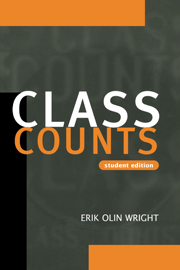Book contents
- Frontmatter
- Contents
- Preface to student edition
- Preface to original edition
- Acknowledgments
- 1 Class analysis
- Part I Structural analyses of classes
- 2 Class structure
- 3 The transformation of the American class structure, 1960–1990
- 4 The fall and rise of the American petty bourgeoisie
- 5 The permeability of class boundaries
- Part II Class and gender
- Part III Class structure and class consciousness
- Part IV Conclusion
- References
- Index
- Index of subjects
3 - The transformation of the American class structure, 1960–1990
Published online by Cambridge University Press: 22 September 2009
- Frontmatter
- Contents
- Preface to student edition
- Preface to original edition
- Acknowledgments
- 1 Class analysis
- Part I Structural analyses of classes
- 2 Class structure
- 3 The transformation of the American class structure, 1960–1990
- 4 The fall and rise of the American petty bourgeoisie
- 5 The permeability of class boundaries
- Part II Class and gender
- Part III Class structure and class consciousness
- Part IV Conclusion
- References
- Index
- Index of subjects
Summary
Two opposed images have dominated discussions of the transformation of class structures in developed capitalist societies. The first of these is associated with the idea that contemporary technological changes are producing a massive transformation of social and economic structures that are moving us towards what is variously called a “post-industrial society” (Bell 1973), a “programmed society” (Touraine 1971), a “service society” (Singelmann 1978; Fuchs 1968) or some similar designation. The second image, rooted in classical Marxist visions of social change, argues that in spite of these transformations of the “forces of production,” we remain a capitalist society and the changes in that class structure thus continue to be driven by the fundamental “laws of motion” of capitalism.
The post-industrial scenario of social change generally envisions the class structure becoming increasingly less proletarianized, requiring higher and higher proportions of workers with technical expertise and demanding less mindless routine and more responsibility and knowledge. For some of these theorists, the central process underwriting this tendency is the shift from an economy centered on industrial production to one based on services. Other theorists have placed greater stress on the emancipatory effects of the technical–scientific revolution within material production itself. In either case the result is a trajectory of changes that undermines the material basis of alienation within production by giving employees progressively greater control over their conditions of work and freedom within work.
- Type
- Chapter
- Information
- Class Counts , pp. 56 - 66Publisher: Cambridge University PressPrint publication year: 2000



